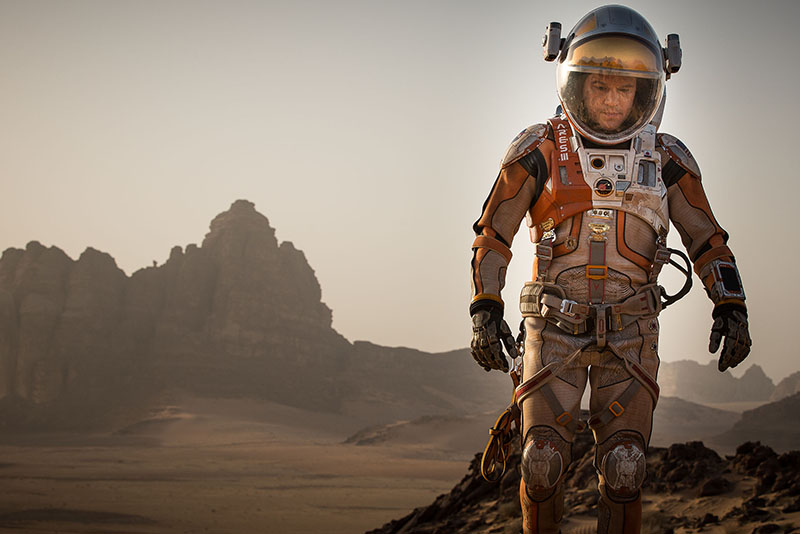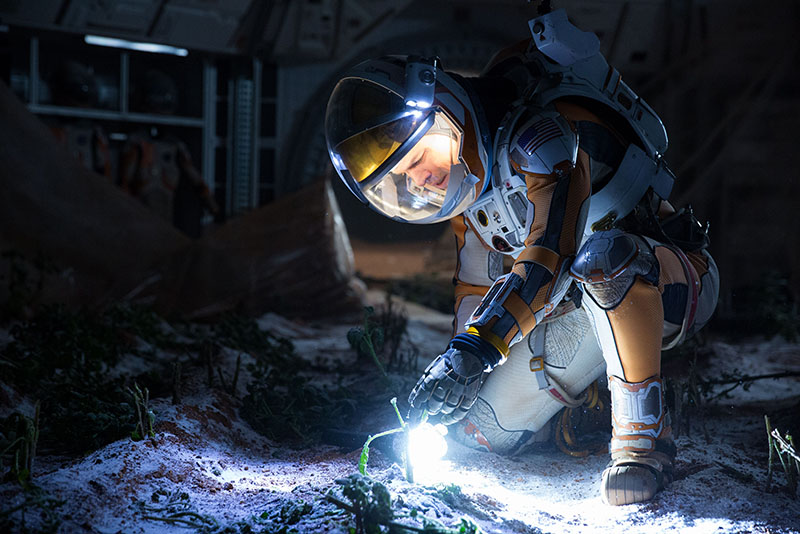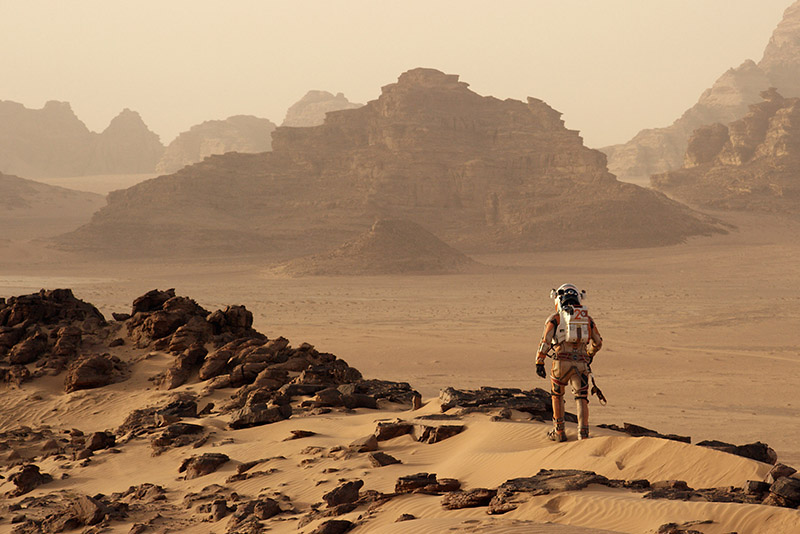The Martian Nails the Science (Mostly)
And yes, scientists are that cool and good-looking

In the new sci-fi blockbuster The Martian, Matt Damon plays botanist Mark Watney, who gets stranded on Mars and survives through scientific ingenuity and derring-do. Photo by Aidan Monaghan
In the new Ridley Scott sci-fi blockbuster The Martian, Matt Damon plays botanist Mark Watney, who gets stranded on Mars after a ferocious sandstorm forces his crew to abort their mission and blast off for Earth. Watney survives through scientific derring-do, figuring out, for instance, how to grow potatoes with his own human waste. “I’m the greatest botanist on the planet,” he announces to a totally deserted Mars.
Let’s leave aside, for the moment, the plausibility of that opening sandstorm. Are scientists in real life always that cool and funny?
Absolutely, says Paul Withers, a Boston University College of Arts & Sciences (CAS) assistant professor of astronomy. An expert on Mars and its weather, Withers recently saw The Martian. Whatever liberties the movie may have taken with scientific reality, he says, it nails the scientists. “All scientists are that handsome—and beautiful,” he says.
For all that moviegoers are falling in love with Matt Damon the botanist, Meghna Sachdev writes in Science magazine, “the story’s real heartthrob is, well, science.” Withers knows all about that. He is a participating scientist on NASA’s MAVEN (Mars Atmosphere and Volatile EvolutioN) mission, which has been circling the Red Planet since 2014 to study its upper atmosphere.
BU Research talked with Withers about the parts of the movie that intersect with his Mars expertise and consulted Nathan Phillips, a CAS professor of earth and environment, who studies the physiology of plants, about those potatoes.

BU Research: Let’s start with the opening scene—are there storms like that on Mars?
Withers: When you have a dust storm in an atmosphere where the surface pressure is scarcely one percent that of Earth—as it is on Mars—it’s incredibly difficult to blow over a steel rocket ship. The wind would huff and puff, but it wouldn’t have enough force to blow the whole house down.
So they wouldn’t have had to abort the mission?
It would still be an unsafe environment to be walking around in, but it wouldn’t severely damage the equipment and not to the extent portrayed. You can have 50- to 100-mile-an-hour winds on Mars. However, it’s such a thin atmosphere that the speed doesn’t pack much of a punch.
Were there other things that seemed implausible to you?
It was difficult to believe that someone would build a giant habitat on the surface of Mars and not put a radio on it. Actually, thinking out loud for a moment, it might be that the antenna for his radio had blown over in the windstorm and he could never get it back.
Let’s bring in Professor Phillips on the botany question. Could Watney have really grown potatoes in his Mars habitat?
Phillips: I haven’t seen the film, but as I imagine it, as long as viable plant material has access to light, water, and nutrients, which I imagine were filtered from waste, and the temperature that’s good for a human (Damon) is generally good for plants, they should grow.
Professor Withers, remember how Matt Damon makes water in the movie—he sets off an explosion—but I wasn’t sure how he got water out of it?
Wasn’t there once water on Mars?
The consensus is that once upon a time in its early history there were substantial amounts of stable liquid water existing on the surface of Mars. The evidence for this comes from the chemistry of ancient rocks, which only makes sense if you accept that they were formed in a wet environment, and from the shapes of channels in the surface that look exactly like dry river channels here on Earth. If you left out a bucket of water on Mars today, it would immediately vaporize into the atmosphere and flash away.

What about NASA figuring out how to rescue Watney on Mars?
By the time anyone finds the money to send humans to Mars, he will have been long dead. It’s been 40 years since humans set foot on the moon. Right now America can’t send astronauts into space. The space shuttle has been retired to museums. The successor spacecraft are not yet operational. There are American astronauts in space, but they’re flying up on Russian rockets. There is an active US human space flight program—it’s just using someone else’s ships.
Did you like the way Mars looked in the movie? It was so red.
That was pretty cool, I liked the colors of things, the expanses of sand everywhere. A couple of things looked strange to my eye. The predominant geological features were those towering buttes with very sharp cliffs on them. I’m not much of a Mars geologist, but I don’t think those are major terrain feature on Mars. I would expect to see a lot more circular features called impact craters, which form when errant asteroids crash into the surface of Mars. Those are very common on Mars, unlike Earth, because the geology of Mars is not active enough to erase them quickly.
Watney got really cold when he was driving around in the rover without the heater to save energy. How cold is Mars?
The temperature is around 50 degrees below zero Fahrenheit to 100 degrees below zero. In order for humans and even robots to function on Mars, they need to have a heater right next to them keeping them warm. The rovers that are driving around on Mars have got little heaters next to their critical computers because those elements couldn’t survive the ambient temperatures.

A lot of people probably didn’t get the time thing with “sols.” What’s a sol?
It was ridiculous they didn’t define that at the start of the movie. On Mars a sol is one day. The Earth rotates on its axis every 24 hours. Mars rotates, coincidentally, every 24 hours and 40 minutes.
Do space scientists work in big teams like they do in the movie?
Space exploration is all about working on teams. In my work on the MAVEN spacecraft, I’m part of a team of a couple of hundred scientists and engineers across the world working to see the spacecraft safely along its journey.
Do they joke back and forth like in the movie?
That pops up in meetings, if only to alleviate the boredom and ennui that any long series of meeting will engender. If you’re part of the team, that means the team has to collaborate and that means lots and lots of meetings.
Overall, how would you rate the movie?
I think it was a great movie and it portrayed a fairly realistic Mars. I look forward to the day when humans are exploring the surface of Mars in the way that Matt Damon and his crew were.
When do you think that might be?
I think it’s going to take a few years—quite a few years.

Comments & Discussion
Boston University moderates comments to facilitate an informed, substantive, civil conversation. Abusive, profane, self-promotional, misleading, incoherent or off-topic comments will be rejected. Moderators are staffed during regular business hours (EST) and can only accept comments written in English. Statistics or facts must include a citation or a link to the citation.